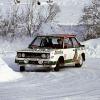Posted 22 March 2000 - 22:25
BRG, your comments about single-wheel bump are correct, but are true of any suspension system. In fact, with a conventional anti-roll bar, the single-wheel bump rate can be significantly higher than the two-wheel bump/pitch/heave rate. It is my understanding that this issue is precisely what led to the development of the 3-spring system -- high single-wheel bump rate decreases the ability to put power down, so the 3-spring system reduces single-wheel bump (and roll) rate while still allowing the car to be stiff relative to pitch/heave -- see PDA's comments. As far as extra parts, the long drop links are there anyway, as they connect to the anti-roll bar in a conventional layout, and the lower pivot replaces the anti-roll bar, so the only extra parts are really the 3rd spring/shock unit itself and its upper mount.
These systems are in use by most teams for at least some tracks -- the 3rd spring can be installed or not at the team's discretion, based on track characteristics. They've also shown up in CART and sportscars.
The monoshocks that were in vogue several years ago were essentially the opposite of this concept -- the spring/shock controlled pitch & heave, but the unit was nearly infinitely stiff in roll. The only roll flexibility at all came from compliances in the components and/or a stack of belleville washers on either side of the single rocker to allow it to move laterally. I talked to a fellow who did some consulting work for some F1 teams in that time, and he confirmed that these systems were very difficult to tune for limit oversteer/understeer balance and were falling out of favor.
PDA, the pivot under the center spring is not necessarily a torsion spring. One common implementation of an anti-roll bar is to have a T-shaped bar in that location that is twisted when the vehicle rolls, but if the rocker for the third spring has a bearing where it connects to the pivot, then that bar will not be twisted. In fact, allowing it to act as a torsion spring will pretty much defeat the whole purpose of the system, which, as you correctly point out, is to reduce single-wheel bump and roll rates.













